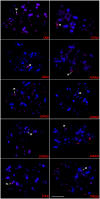Evolution of bird sex chromosomes: a cytogenomic approach in Palaeognathae species
- PMID: 38654159
- PMCID: PMC11036779
- DOI: 10.1186/s12862-024-02230-5
Evolution of bird sex chromosomes: a cytogenomic approach in Palaeognathae species
Abstract
Background: Different patterns of sex chromosome differentiation are seen in Palaeognathae birds, a lineage that includes the ratites (Struthioniformes, Rheiformes, Apterygiformes, Casuariiformes, and the sister group Tinamiformes). While some Tinamiform species have well-differentiated W chromosomes, both Z and W of all the flightless ratites are still morphologically undifferentiated. Here, we conducted a comprehensive analysis of the ZW differentiation in birds using a combination of cytogenetic, genomic, and bioinformatic approaches. The whole set of satDNAs from the emu (Dromaius novaehollandiae) was described and characterized. Furthermore, we examined the in situ locations of these satDNAs alongside several microsatellite repeats and carried out Comparative Genomic Hybridizations in two related species: the greater rhea (Rhea americana) and the tataupa tinamou (Crypturellus tataupa).
Results: From the 24 satDNA families identified (which represent the greatest diversity of satDNAs ever uncovered in any bird species), only three of them were found to accumulate on the emu's sex chromosomes, with no discernible accumulation observed on the W chromosome. The W chromosomes of both the greater rhea and the emu did not exhibit a significant buildup of either C-positive heterochromatin or repetitive DNAs, indicating their large undifferentiation both at morphological and molecular levels. In contrast, the tataupa tinamou has a highly differentiated W chromosome that accumulates several DNA repeats.
Conclusion: The findings provide new information on the architecture of the avian genome and an inside look at the starting points of sex chromosome differentiation in birds.
Keywords: Birds; Evolution; Molecular cytogenetics; Nascent sex chromosomes; satDNAs.
© 2024. The Author(s).
Conflict of interest statement
The authors declare no competing interests.
Figures






References
-
- Bull JJ. Evolution of sex determining mechanisms. Benjamin/Cummings: Menlo Park; 1983.
-
- Ohno S. Sex chromosomes and sex-linked genes. Berlin, Heidelberg: Springer Berlin Heidelberg; 1967.
Publication types
MeSH terms
LinkOut - more resources
Full Text Sources
